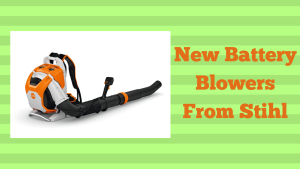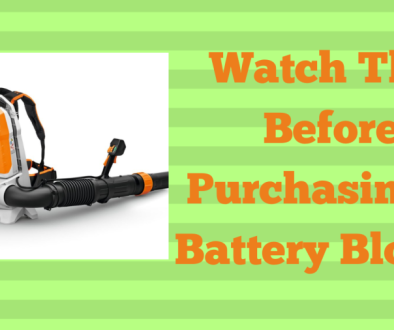New Battery Blowers From Stihl

Today, I want to share a detailed look at two new battery backpack blowers from STIHL – the BGA 500 and the larger BGA 600. These are part of STIHL’s AP system of cordless tools, designed to give professional performance without the need for petrol.
Model Confusion: 500 vs 600
First off, the numbering can be a bit confusing. The BGA 500 is roughly equivalent to the STIHL BR600 petrol blower, while the BGA 600 compares to the STIHL BR700 or BR800. I’m not sure why STIHL didn’t keep the numbering in line with their petrol models – it would certainly make comparisons easier.
Stepping Up from the BGA 300
A couple of years ago, STIHL released their first cordless backpack blower, the BGA 300. While it performed well for a battery blower, the new 500 and 600 models are significantly more powerful, offering performance that genuinely rivals petrol machines.
Power and Performance
Both machines use STIHL’s 72V AP battery system. The recommended option is the AP500 battery, which delivers the longest runtime. The BGA 600 achieves a maximum blowing force of 35 Newtons with a round nozzle, putting it right in line with STIHL’s higher-end petrol models.
Runtime Estimates
- BGA 500: 20–39 minutes (with AP500 battery)
- BGA 600: 34–80 minutes (with AP500 battery)
While these runtimes are respectable, if you’re working all day – for example, blowing leaves or clearing large areas – you’ll likely need extra batteries or a way to charge on the go.
Weight Comparison
The BGA 600 weighs around 14.5kg with batteries, compared to about 11.7kg for the BR800 petrol blower. On paper, that’s a noticeable difference. However, in practice, I’ve found that STIHL’s petrol backpack blowers, such as the BR600 I own, never feel too heavy. The harness system helps distribute weight comfortably, so the extra kilos with the battery version may not be a big issue.
Pricing and Setup Costs
This is where things get interesting. Here’s a breakdown of the current prices (including VAT):
- BGA 600: £1,029 (blower unit only, no batteries)
- AP500 batteries: £429 each – you’ll need two
- Standard charger: approx. £149
- Multi-battery charger: just over £300
That means your total setup cost can easily climb well above £2,000. In contrast, the STIHL BR600 Magnum petrol blower is available for around £964, ready to use as soon as you add fuel.
Features I Appreciate
- Consistent Power: STIHL’s intelligent batteries maintain consistent performance right until they’re flat, unlike some other brands where output declines as the charge drops.
- No Starting Hassles: Just slot in the battery and press the switch – no fuel, no pulling cords.
- Low Maintenance: No spark plugs, carburettors, or fuel issues to deal with.
- Quiet Operation: Significantly quieter than petrol blowers, which is a big plus in noise-sensitive areas.
Potential Drawbacks
- Cost: The upfront cost is much higher than petrol models.
- Runtime Limitations: With 20–80 minutes depending on the model, you’ll likely need extra batteries for long jobs.
- Weight: Slightly heavier once you add the batteries, although not unmanageable.
Battery Interchangeability
One advantage of STIHL’s AP system is that the same batteries can be used across their range of cordless tools – from hedge trimmers and chainsaws to strimmers and lawnmowers. If you’re already invested in STIHL’s battery tools, this makes the blowers more appealing as you can share batteries between machines, reducing the overall cost.
Accessories and Charging Options
For professionals, STIHL also offers a battery power supply pack at around £3,869 – though this won’t be practical for most. More realistically, a vehicle charging system is a sensible investment for contractors who need to charge batteries on the go between jobs.
How Do They Compare to Petrol Models?
Having used several STIHL petrol blowers over the years, including the BR600 Magnum, I can say they’re excellent machines. The BR600 offers great power, reliability, and a lightweight feel. The BR800 is even more powerful, designed for heavy-duty use with superb blowing force. Both are proven, dependable tools.
Battery models like the BGA 500 and BGA 600 offer the advantage of quiet, emission-free operation with instant starting, but you need to factor in the higher costs and potential need for multiple batteries.
My Thoughts and Experience
I personally still prefer petrol models for their unlimited runtime and lower setup costs. However, many contractors and homeowners I know are moving to battery, and the feedback on STIHL’s cordless tools has been positive. If you’re mainly doing short jobs like cleaning up after garden work, the runtime may be more than enough, and the quiet operation is a huge benefit.
For those working all day, investing in several batteries or a vehicle charger is almost essential. Over time, you save on fuel costs, which does offset the investment somewhat.
Conclusion
The STIHL BGA 500 and BGA 600 are well-built, powerful, and efficient battery backpack blowers. If you’re already in the STIHL AP ecosystem, these could be a smart choice. But if you’re not ready for the high upfront costs, the BR600 or BR800 petrol blowers remain excellent, cost-effective options.
I’d love to hear your experience: Have you used the STIHL BGA 500 or 600? How do you find them compared to petrol blowers? Please share your thoughts in the comments below.


